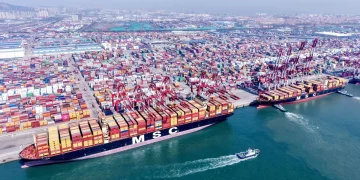Introduction
The Asia-Pacific (APAC) region, comprising major economies such as China, Japan, India, South Korea, and Australia, has become a significant engine of global economic growth and an increasingly vital area for financial markets. As the world’s second-largest economic region, Asia-Pacific not only influences regional markets but also has substantial implications for global trade, investments, and capital flows. For global investors, understanding the latest developments in APAC financial markets is crucial, as shifts in economic performance, political stability, and regulatory changes can significantly affect asset prices and risk levels worldwide.
This article explores the latest dynamics in the Asia-Pacific financial markets and examines their potential impacts on global investors. We will analyze key economic indicators, market trends, and geopolitical factors that are shaping the investment environment in the region, and assess how these factors can influence investment decisions and strategies in global markets.
Section 1: The Role of Asia-Pacific Financial Markets in the Global Economy
The Asia-Pacific region represents a growing portion of the global economy, accounting for about 40% of global GDP, with its market developments increasingly having a far-reaching impact on international financial markets. Over recent decades, APAC has been the center of dynamic economic and financial growth, with several countries in the region showing resilience and growth in the face of global economic challenges. Notably, China and India are major players, with their enormous populations and rapidly developing economies acting as growth engines for the region.
Key Economic Drivers in APAC:
- China: As the second-largest economy in the world, China’s economic health and financial market performance have global consequences. Key factors such as economic growth rates, government policies, and regulatory changes in China directly affect international markets, particularly in commodities, technology, and global supply chains.
- India: With a fast-growing middle class, India has become a key player in global investment strategies, particularly in sectors such as technology, pharmaceuticals, and services. India’s financial market performance also has an increasingly significant effect on regional and global market trends.
- Japan and South Korea: These advanced economies are leaders in technology and manufacturing, contributing to supply chains and global demand in sectors like electronics, automobiles, and semiconductors.
The Importance of APAC to Global Investors:
For investors, the APAC region is a vital source of both risk and opportunity. The region’s financial markets, particularly in countries like Japan, China, and Australia, are highly liquid and offer significant opportunities for portfolio diversification. Moreover, the growing middle class in countries such as China and India presents vast growth potential for investors in consumer-driven industries. However, geopolitical risks, regulatory changes, and financial market volatility can also expose global investors to increased risk.
Section 2: Key Trends Shaping the Asia-Pacific Financial Markets
Several major trends in the Asia-Pacific financial markets are currently unfolding, influencing global investor strategies. These include technological advancements, economic shifts, regulatory changes, and geopolitical developments.
1. Rising Market Volatility
In recent months, APAC financial markets have faced heightened volatility. This volatility can be attributed to several factors:
- Economic Slowdown: Some of the major economies in APAC, especially China, have been facing slowdowns in economic growth, which has led to concerns over the future trajectory of the region’s markets. For instance, China’s slowdown has been attributed to both internal factors (such as the property crisis) and external factors (such as trade tensions and the global economic environment).
- Interest Rates and Inflation: As global inflation concerns persist, central banks in APAC countries, such as the Reserve Bank of Australia (RBA) and the Bank of Japan (BoJ), have been adjusting interest rates. Rising interest rates can increase the cost of borrowing, which can slow down consumer spending and corporate investment. However, these rate hikes also offer better returns on bonds and savings products, which may attract international investors seeking safer, fixed-income investments.
- Currency Fluctuations: Many APAC countries, including Japan, India, and South Korea, are facing fluctuations in their currency values, which affect trade balances, inflation rates, and the overall financial stability of their economies. These currency fluctuations can significantly impact multinational corporations and global investors with exposure to these markets.
2. China’s Economic Transition
China’s economic growth is transitioning from a manufacturing-based economy to a more consumption- and service-oriented model. This shift has substantial implications for financial markets:
- Trade Policy and Geopolitics: Trade tensions between China and other major economies, particularly the United States, continue to impact the region. The ongoing trade war between the two nations has led to tariffs on a wide range of goods, disrupting global supply chains and affecting investor sentiment.
- Regulatory Crackdown: The Chinese government has also implemented a range of regulatory measures aimed at curbing the power of large tech firms, restricting financial leverage, and addressing issues of wealth inequality. These moves have led to significant market reactions, particularly in the technology and real estate sectors. Investors must pay close attention to regulatory changes in China, as they can impact market behavior and future growth prospects for Chinese companies.
3. Technological Innovation and Digital Transformation
Asia-Pacific is a hotbed for technological innovation, particularly in China, Japan, and South Korea. The region is home to leading tech companies such as Tencent, Alibaba, Samsung, and Sony, and is the driving force behind trends in e-commerce, artificial intelligence (AI), and fintech. The digital transformation is having a profound impact on financial markets:
- E-Commerce and Consumer Technology: As Asia’s middle class grows, demand for online services, digital goods, and consumer technology continues to rise. This presents vast opportunities for investors in technology stocks, digital payments companies, and e-commerce platforms. Additionally, the growing adoption of mobile banking and online financial services in APAC countries like India and Southeast Asia is spurring growth in the fintech sector.
- Artificial Intelligence and Automation: With significant investments in AI, robotics, and automation, particularly in Japan and South Korea, the region is likely to remain at the forefront of innovation. For global investors, this means that sectors such as robotics, semiconductors, and data processing will continue to be crucial areas of focus.
4. Geopolitical Tensions and Regional Stability
Geopolitical factors, including territorial disputes, military tensions, and shifts in political power, can introduce volatility into the Asia-Pacific financial markets. Key areas to monitor include:
- China and the South China Sea: Territorial disputes in the South China Sea and China’s growing military presence in the region remain a source of tension. For investors, these geopolitical risks can have implications for regional stability, impacting trade routes, commodity prices, and market confidence.
- India-Pakistan Relations: Political and military tensions between India and Pakistan have periodically spiked, and any escalation could lead to volatility in regional financial markets, particularly in sectors sensitive to geopolitical risks.
- North Korea and Regional Security: North Korea’s actions and the potential for military escalation in the region also pose risks for investor confidence in countries like South Korea and Japan. Geopolitical instability can lead to sharp fluctuations in asset prices, particularly in risk-sensitive markets.

Section 3: Implications for Global Investors
Given the rapidly changing financial environment in the Asia-Pacific region, global investors must closely monitor developments and adjust their strategies accordingly. Below are the key takeaways and implications for global investors:
1. Opportunities in Emerging Markets
Countries like India, Vietnam, and Indonesia offer attractive growth opportunities due to their youthful populations, expanding middle classes, and increasing demand for consumer goods and services. However, these emerging markets are also more susceptible to risks such as political instability, currency fluctuations, and inflationary pressures. Therefore, global investors should diversify their investments and consider exposure to multiple emerging markets within the APAC region to mitigate risk.
2. Navigating the China Risk
China’s regulatory crackdown and economic slowdown pose risks for investors who are heavily invested in Chinese equities or sectors such as real estate, technology, and finance. While China continues to be an important driver of global growth, global investors must remain vigilant about government policies that may affect corporate profits, stock prices, and the overall market outlook.
Investors may look to reduce their exposure to Chinese stocks or diversify into other APAC economies that offer stronger growth prospects and less regulatory uncertainty. Additionally, sectors such as renewable energy, semiconductors, and consumer technology are likely to benefit from China’s ongoing economic transition.
3. Technological and Fintech Growth
Investors looking for high-growth opportunities should focus on the thriving technology and fintech sectors in APAC. As the digital transformation accelerates across the region, companies in e-commerce, mobile payments, cloud computing, AI, and automation will likely continue to see strong growth. Countries like China, South Korea, and India are poised to remain leaders in these sectors, providing exciting investment prospects.
4. Geopolitical Risks and Market Volatility
Geopolitical risks in the APAC region—whether related to territorial disputes, military tensions, or political instability—can cause market volatility. Investors should be prepared for potential market fluctuations and consider hedging strategies, such as investing in gold or other safe-haven assets, in the event of heightened geopolitical risks. Additionally, regional ETFs or funds that provide diversified exposure to APAC markets can help mitigate risks associated with individual countries or sectors.
Section 4: Conclusion
The latest developments in the Asia-Pacific financial markets present both opportunities and risks for global investors. While the region offers significant growth potential, particularly in emerging markets, technology, and digital transformation, it also poses challenges, including geopolitical tensions, regulatory changes, and economic slowdowns. Global investors must stay informed about market trends, adjust their investment strategies accordingly, and carefully consider the risks associated with investing in this dynamic region. By maintaining a diversified portfolio and focusing on sectors with long-term growth potential, investors can capitalize on the opportunities offered by the Asia-Pacific financial markets while managing the associated risks.

































